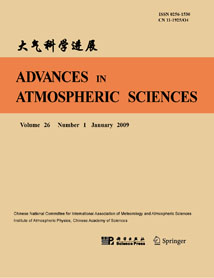| [1] |
Soo PARK, Seung Jin, Chang Seok,
2013: Effects of an Urban Park and Residential Area on the Atmospheric CO2 Concentration and Flux in Seoul, Korea, ADVANCES IN ATMOSPHERIC SCIENCES, 30, 503-514.
doi: 10.1007/s00376-012-2079-7
|
| [2] |
JIANG Chunming, YU Guirui, CAO Guangmin, LI Yingnian, ZHANG Shichun, FANG Huajun,
2010: CO2 Flux Estimation by Different Regression Methods from an Alpine Meadow on the Qinghai-Tibetan Plateau, ADVANCES IN ATMOSPHERIC SCIENCES, 27, 1372-1379.
doi: 10.1007/s00376-010-9218-9
|
| [3] |
ZHANG Feng, ZENG Qingcun, Y.GU, K.N.LIOU,
2005: Parameterization of the Absorption of the H2O Continuum, CO2, O2, and Other Trace Gases in the Fu-Liou Solar Radiation Program, ADVANCES IN ATMOSPHERIC SCIENCES, 22, 545-558.
doi: 10.1007/BF02918487
|
| [4] |
Jing Peng, Li Dan, xiba tang,
2023: Spatial variation in CO2 concentration improves simulated surface air temperature increase in the Northern Hemisphere, ADVANCES IN ATMOSPHERIC SCIENCES.
doi: 10.1007/s00376-023-3249-5
|
| [5] |
L.S. Hingane,
1989: Effect of Increasing CO2 on the Stratospheric Level of CO and O3, ADVANCES IN ATMOSPHERIC SCIENCES, 6, 390-392.
doi: 10.1007/BF02661544
|
| [6] |
A. Longhetto, S. Ferrarese, C. Cassardo, C. Giraud, F. Apadttla, P. Bacci, P. Bonelli, A. Marzorati,
1997: Relationships between Atmospheric Circulation Patterns and CO2 Greenhouse-Gas Concentration Levels in the Alpine Troposphere, ADVANCES IN ATMOSPHERIC SCIENCES, 14, 309-322.
doi: 10.1007/s00376-997-0052-7
|
| [7] |
Changyu LI, Jianping HUANG, Lei DING, Yu REN, Linli AN, Xiaoyue LIU, Jiping HUANG,
2022: The Variability of Air-sea O2 Flux in CMIP6: Implications for Estimating Terrestrial and Oceanic Carbon Sinks, ADVANCES IN ATMOSPHERIC SCIENCES, 39, 1271-1284.
doi: 10.1007/s00376-021-1273-x
|
| [8] |
Lingyun ZHANG, Yanfang SONG, Jialin SHI, Qun SHEN, Deng HU, Qiang GAO, Wei CHEN, Kien-Woh KOW, Chengheng PANG, Nannan SUN, Wei WEI,
2022: Frontiers of CO2 Capture and Utilization (CCU) towards Carbon Neutrality, ADVANCES IN ATMOSPHERIC SCIENCES, 39, 1252-1270.
doi: 10.1007/s00376-022-1467-x
|
| [9] |
Xu Yongfu,
1992: The Buffer Capability of the Ocean to Increasing Atmospheric CO2, ADVANCES IN ATMOSPHERIC SCIENCES, 9, 501-510.
doi: 10.1007/BF02677083
|
| [10] |
XU Yongfu, LI Yangchun,
2009: Estimates of Anthropogenic CO2 Uptake in a Global Ocean Model, ADVANCES IN ATMOSPHERIC SCIENCES, 26, 265-274.
doi: 10.1007/s00376-009-0265-z
|
| [11] |
WANG Yuesi, WANG Yinghong,
2003: Quick Measurement of CH4, CO2 and N2O Emissions from a Short-Plant Ecosystem, ADVANCES IN ATMOSPHERIC SCIENCES, 20, 842-844.
doi: 10.1007/BF02915410
|
| [12] |
Dongxu YANG, Janne HAKKARAINEN, Yi LIU, Iolanda IALONGO, Zhaonan CAI, Johanna TAMMINEN,
2023: Detection of Anthropogenic CO2 Emission Signatures with TanSat CO2 and with Copernicus Sentinel-5 Precursor (S5P) NO2 Measurements: First Results, ADVANCES IN ATMOSPHERIC SCIENCES, 40, 1-5.
doi: 10.1007/s00376-022-2237-5
|
| [13] |
Wang Gengchen, Kong Qinxin,
1984: AN EXPERIMENTAL STUDY ON ABSORPTION PROPERTIES OF NO, N0_2, NH_3, CO_2 AND H_2O BY USING LINE-TUNABLE CO LASER, ADVANCES IN ATMOSPHERIC SCIENCES, 1, 112-127.
doi: 10.1007/BF03187622
|
| [14] |
LI Yangchun, XU Yongfu,
2012: Uptake and Storage of Anthropogenic CO2 in the Pacific Ocean Estimated Using Two Modeling Approaches, ADVANCES IN ATMOSPHERIC SCIENCES, 29, 795-809.
doi: 10.1007/s00376-012-1170-4
|
| [15] |
Yujie JING, Yangchun LI, Yongfu XU, Guangzhou FAN,
2019: Influences of the NAO on the North Atlantic CO2 Fluxes in Winter and Summer on the Interannual Scale, ADVANCES IN ATMOSPHERIC SCIENCES, 36, 1288-1298.
doi: 10.1007/s00376-019-8247-2
|
| [16] |
Boru MAI, Xuejiao DENG, Fang ZHANG, Hao HE, Tian LUAN, Fei LI, Xia LIU,
2020: Background Characteristics of Atmospheric CO2 and the Potential Source Regions in the Pearl River Delta Region of China, ADVANCES IN ATMOSPHERIC SCIENCES, 37, 557-568.
doi: 10.1007/s00376-020-9238-z
|
| [17] |
Guo Yufu, Yu Yongqiang, Liu Xiying, Zhang Xuehong,
2001: Simulation of Climate Change Induced by CO2 Increasing for East Asia with IAP/LASG GOALS Model, ADVANCES IN ATMOSPHERIC SCIENCES, 18, 53-66.
doi: 10.1007/s00376-001-0004-6
|
| [18] |
Ning ZENG,
2003: Glacial-Interglacial Atmospheric CO2 Change--The Glacial Burial Hypothesis, ADVANCES IN ATMOSPHERIC SCIENCES, 20, 677-693.
doi: 10.1007/BF02915395
|
| [19] |
ZHANG Hua, ZHANG Ruoyu, and SHI Guangyu,
2013: An updated estimation of radiative forcing due to CO2 and its effect on global surface temperature change, ADVANCES IN ATMOSPHERIC SCIENCES, 30, 1017-1024.
doi: 10.1007/s00376-012-2204-7
|
| [20] |
KOU Xingxia, ZHANG Meigen, PENG Zhen, WANG Yinghong,
2015: Assessment of the Biospheric Contribution to Surface Atmospheric CO2 Concentrations over East Asia with a Regional Chemical Transport Model, ADVANCES IN ATMOSPHERIC SCIENCES, 32, 287-300.
doi: 10.1007/s00376-014-4059-6
|















 AAS Website
AAS Website 
 AAS WeChat
AAS WeChat 
 DownLoad:
DownLoad: